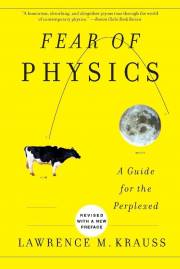 “Assume the cow is a sphere.” So begins this lively, irreverent, and informative look at everything from the physics of boiling water to cutting-edge research at the observable limits of the universe. Rich with anecdotes and accessible examples, Fear of Physics nimbly ranges over the tools and thought behind the world of modern physics, taking the mystery out of what is essentially a very human intellectual endeavour.
“Assume the cow is a sphere.” So begins this lively, irreverent, and informative look at everything from the physics of boiling water to cutting-edge research at the observable limits of the universe. Rich with anecdotes and accessible examples, Fear of Physics nimbly ranges over the tools and thought behind the world of modern physics, taking the mystery out of what is essentially a very human intellectual endeavour.
Fear of Physics is a lively, irreverent, and informative look at everything from the physics of boiling water to cutting-edge research at the observable limits of the universe. Rich with anecdotes and accessible examples, it nimbly ranges over the tools and thought behind the world of modern physics, taking the mystery out of what is essentially a very human intellectual endeavor.
EDITORIAL REVIEWS
FROM PUBLISHERS WEEKLY
Copyright 1993 Reed Business Information, Inc.
FROM LIBRARY JOURNAL
– Diane M. Fortner, Univ. of California Lib., Berkeley
Copyright 1993 Reed Business Information, Inc.
FROM KIRKUS REVIEWS
Physics made easy this is not. Physics for the sophisticated but nontechnical, maybe. Krauss is a theoretical physicist who teaches one of those physics-for-poets courses at Yale. This volume, though, is a lofty view of certain unifying themes with particular reference to particle physics and quantum mechanics. The first section deals with process, describing how physicists work by excluding the irrelevant. Thus a cow can be reduced to a sphere or maybe a sphere attached by a pipe to a smaller sphere. By a simple application of scaling laws relating to area and volume, one can show that a huge “supercow” is not possible without radically altering the dimensions or the materials involved. Galileo excluded the effects of the medium to demonstrate that all objects fall at the same rate, and so on. Process also depends on mathematics, so Krauss enlarges on the use of orders-of- magnitude notation in science. In the second section, he explains how scientific revolutions (pace Thomas Kuhn) do not throw out the past so much as extend and revise theory to suit new scales of observation. So we go from Galileo and Newton to Einstein and special relativity to Hawking and black holes, with emphasis on how fundamental laws of force and motion hold at one scale but are revised at the quantum level. The last parts of the book are really very elegant discussions of unifying principles and symmetries, such as the equivalence of mass and energy and electricity and magnetism. Krauss introduces gauge theory, argues for the superconducting supercollider to seek the Higgs particle, discusses the possible “end” of physics, and–new to books of this type- -describes condensed matter physics, by which one can demonstrate that water and iron behave the same way at certain critical points. Less a guide for the perplexed than a theoretical introduction to the weirdness and beauty of the universe. — Copyright ┬®1993, Kirkus Associates, LP. All rights reserved.
ABOUT THE AUTHOR
–This text refers to the Paperback edition.
